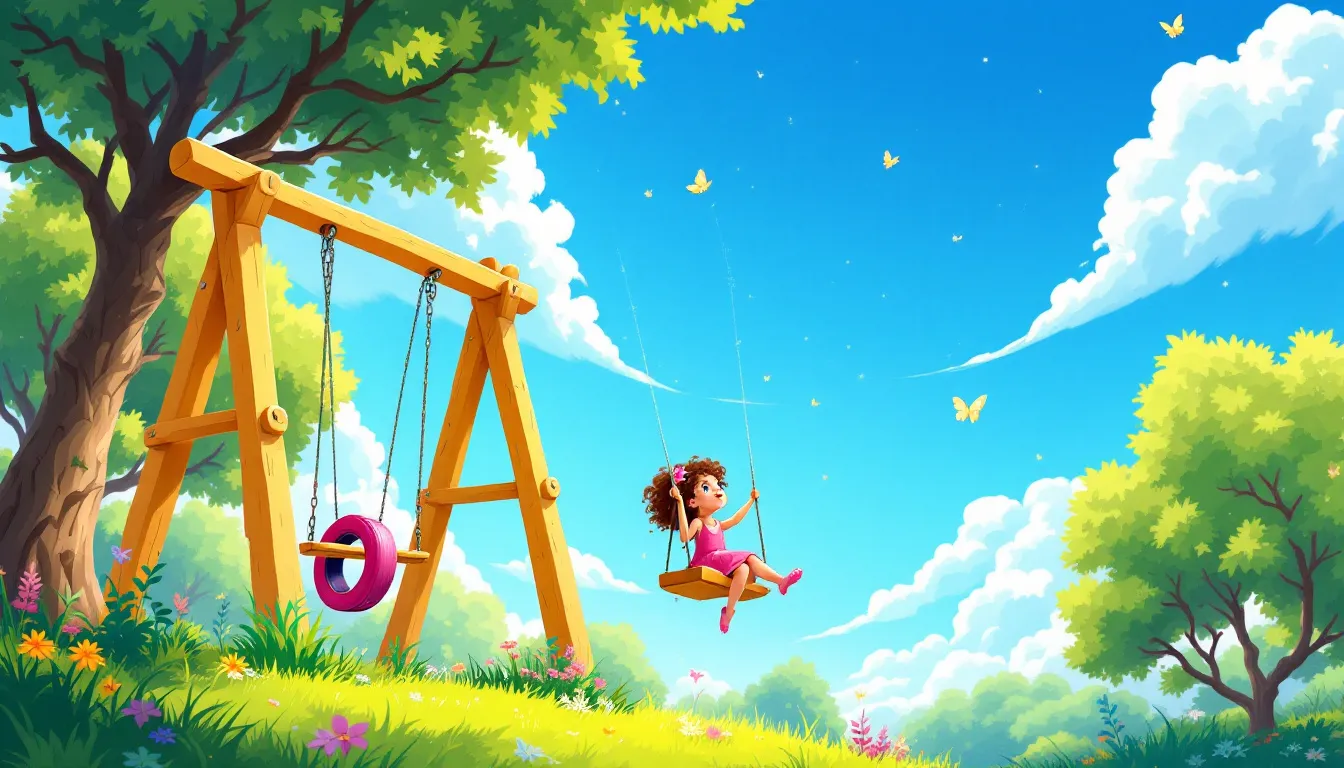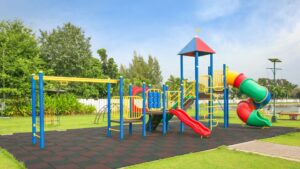Searching for a park with swings for your kids? Swings are a playground classic, offering joy and developmental benefits. In this article, we cover why kids love parks with swings and the types you can expect to find.
Key Takeaways
- Swings are essential park features that foster physical, social, and mental development in children, offering both fun and exercise.
- A variety of swing types, including belt, tire, web, and inclusive swings, ensure all kids can find a suitable option, promoting engagement and cooperation.
- Proper planning for swing placement, safety standards, and the inclusion of accessories can enhance park experiences, making playspaces more enjoyable and welcoming for everyone.
The Importance of Swings in Parks

Swings are a cornerstone of park design, attracting children and families. Beyond being playground equipment, they create vibrant, engaging play spaces. Swings enhance social interaction, allowing kids to enjoy a common activity together, whether making new friends or playing with siblings. They also cater to individual play, offering children joy and solace in the rhythmic motion of swinging.
Swinging promotes physical exercise, helping build motor skills and strength as kids pump their legs and hold onto the chains. The movement challenges their coordination and balance, making it both fun and beneficial for physical health. Modern swings are durable, withstanding heavy use and encouraging endless hours of imaginative outdoor play.
Swings are a timeless attraction, enjoyed by generations of children. Their unmatched joy makes them a must-have in any park. Swings draw kids to the playground and keep them engaged, aiding in physical, social, and mental development. It’s no wonder that swings are a perennial favorite in parks worldwide.
Popular Types of Swings Found in Parks

Parks today offer a variety of swings, from classic belt swings to innovative web swings, catering to different needs and preferences. These swings add diversity to playgrounds, ensuring children of all ages and abilities can find a suitable swing.
Common swing types in parks include:
- Belt swings, which offer comfort and support for children
- Tire swings, which provide group play potential and fun for multiple users
- Web swings, which allow for a unique seating arrangement and can accommodate several children at once
- Inclusive seats, designed for children with varying abilities to ensure everyone can enjoy swinging
Each swing type has unique features and benefits for various age groups and play styles. Whether it’s the comfort of belt swings, the group play potential of tire swings, or the inclusivity of specially designed seats, these swings create dynamic and engaging play areas.
Traditional Belt Swings
Traditional belt swings, or sling swings, are park staples. They feature slash-proof seats and steel frames, ensuring durability and safety for older kids who enjoy freedom while swinging. Designed with safety in mind, these swings incorporate features like anti-wrap swing hangers and extended fall surfacing, making the belt swing a popular choice.
Belt swings are popular among older children, offering a comfortable and adaptable swinging experience with a dynamic range of motion. Their robustness and design make them a preferred choice for those seeking both comfort and adventure.
Tire Swings
Tire swings add endless fun and versatility to any playground, accommodating up to three kids at once for group play. Unlike traditional swings, a tire swing moves in multiple directions, including circular motion, adding extra excitement.
Tire swings’ capacity to support multiple kids simultaneously promotes cooperative play and teamwork. Children learn to coordinate and share the swing, enhancing social skills and making playtime more engaging. The versatility and group play potential of tire swings make them a beloved park feature.
Web Swings
Web swings, another popular choice in parks, accommodate up to four kids at once, promoting group interaction and collaborative play.
The basket swing variant of web swings offers multi-child capacity and traditional back-and-forth motion, making it a versatile and engaging option for a web swing.
Inclusive Swing Seats
Inclusive swing seats ensure children of all abilities can safely enjoy swinging, featuring supportive designs with safety harnesses for added security.
Catering to children aged 2 to 12, inclusive swing seats are a valuable addition to parks aiming for an inclusive and welcoming play environment.
Choosing the Right Swings for Your Park

Choosing the right swings for your park requires considering safety, suitability, and enjoyment for all children. A primary consideration is the age range of children using the swings. Different swings cater to age groups, from toddlers to older kids, ensuring an appropriate and enjoyable swinging experience for each child.
Besides age considerations, planning the space and layout of swings carefully is crucial. Swing bays can be customized with different configurations for various park designs and user capacities. Positioning swings away from other playground equipment and providing shaded areas enhances safety and comfort for all children.
Age Range Considerations
Different age groups have varying needs and preferences for swings. For instance, tire swings suit children aged 2 to 12, allowing kids of different ages to enjoy swinging together. Bucket seats are specifically designed for preschool children under five, providing necessary support and safety for younger kids.
Traditional belt swings are optimal for older kids, offering a dynamic swinging experience. Matching swings to the ages of children using them promotes both safety and enjoyment. Catering swings to the appropriate age group significantly enhances the play experience for all children.
Space and Layout Planning
Proper space and layout planning maximize safety and enjoyment in playgrounds. Swings should be positioned away from other equipment to prevent accidents and ensure a safe play environment. A dedicated bay for swings allows for the extra space needed for safe swinging.
Shaded areas in playgrounds enhance comfort, especially for children with heat sensitivity. Accessible pathways should be wide enough for wheelchairs, encouraging shared activities among all children and promoting inclusivity.
Meeting Safety Standards
Meeting safety standards is paramount when installing swing sets in parks. Swing sets must comply with safety regulations for proper installation and maintenance. For example, the fall zone for belt swings should be at least six feet in all directions to prevent injuries.
Enhancing safety can also involve incorporating protective surfacing like rubber mats on accessible routes. These measures ensure that all children, regardless of ability, can safely enjoy the playground.
Enhancing Park Experience with Swing Accessories

Adding accessories to swings significantly enhances the park experience for children. Special swing chains, seats, and interactive features boost children’s enjoyment and engagement during playtime. Customizing these elements creates a more personalized and exciting play environment.
From durable swing chains to different seat options, various ways exist to enhance the functionality and appeal of swings. Integrating these accessories makes a significant difference in creating a dynamic and inclusive play space.
Swing Chains and Seats
Swing chains come in various materials and coatings, such as galvanized steel or Plastisol, enhancing aesthetics and grip. Coated chains provide better grip and durability, making them safer for kids. Customizable seat options, including belt and bucket seats, ensure swings can accommodate children of various ages and abilities.
Offering a range of seat options promotes inclusive play, allowing all children to enjoy swinging. Belt seats are ideal for older children, providing greater freedom of movement and play.
Swing Bays and Beams
Swing bay and swing beam can be customized to suit different park layouts and user needs. Flexible design and installation allow for unique configurations that enhance the play experience. Commercial playground swings offer durability and various bay options, ensuring parks can cater to a wide range of children.
Adding more bays increases the capacity for group play, making the playground double the fun and enjoyable for all children.
Interactive Features
Incorporating interactive elements like rock walls and imaginative play structures near swings creates a more engaging environment for children. These features enhance the play experience, stimulating children’s creativity and encouraging physical activity.
Benefits of Swinging for Children
Swinging offers numerous benefits, making it a vital playground component. It provides an excellent environment for physical exercise, helping children develop strength and coordination. Swinging fosters social interaction, as children learn to take turns and support each other during play.
Swinging also offers significant mental health benefits, aiding emotional regulation, providing a calming effect, and helping children focus better. The combination of physical, social, and mental benefits makes swinging essential for children’s overall development.
Physical Exercise
Swinging is a fun and engaging activity promoting physical exercise. It allows kids to pump their feet, exploring movement while working large muscle groups. Swinging engages core muscles, aiding in developing strength and coordination.
Overall, swinging enhances physical activity, leading to better muscle development and coordination. It’s an enjoyable way for kids to stay active and healthy while having fun.
Social Interaction
Swinging fosters social skills by encouraging children to take turns and support each other during play. Group swings like tire swings promote sharing and coordination among several kids, enhancing social interaction.
Group swings also encourage cooperative play, where kids learn to work together and communicate effectively. Swinging’s social benefits make it valuable for children’s development.
Mental Well-being
Swinging provides soothing stress relief and can significantly reduce anxiety in children. The rhythmic motion of swinging helps in emotional regulation and increases blood flow to the brain, aiding in better focus and mental well-being.
Creating Inclusive Play Spaces
Incorporating multiple swing types can help accommodate children of different ages and abilities, making play spaces more inclusive. Swing seats are available in various styles, including infant, toddler, and specialized seats for children with particular needs.
Adding accessories like swings with canopies can provide shade and enhance comfort during sunny days. Effective signage that uses symbols and pictures can help non-verbal and early-learning children communicate more easily in playground settings.
Summary
Swings are an essential feature in any park, providing numerous benefits for children. From promoting physical exercise and social interaction to enhancing mental well-being, swings play a crucial role in children’s development. Choosing the right swings, planning the space and layout, and meeting safety standards are vital steps in creating a fun and safe play environment.
By incorporating various swing types and accessories, parks can offer an inclusive and engaging play experience for all children. So, the next time you visit a park, take a moment to appreciate the magic of swings and the joy they bring to kids everywhere.
Frequently Asked Questions
What age groups are traditional belt swings suitable for?
Traditional belt swings are perfect for older kids who are looking for a fun and adventurous swinging experience. They offer a comfortable ride while allowing for more dynamic play.
How do tire swings promote group play?
Tire swings are great for group play because they can hold multiple kids at once and swing in different directions, encouraging teamwork and interaction. It’s a fun way for kids to work together while having a blast!
What safety features are included in inclusive swing seats?
Inclusive swing seats prioritize safety by incorporating supportive designs and safety harnesses to prevent falls, making them safe and accessible for children aged 2 to 12. This ensures every child can enjoy swinging without worry.
Why is space and layout planning important for swings in parks?
Space and layout planning for swings in parks is crucial for safety, as it keeps them away from other equipment to prevent accidents. Plus, thoughtful design creates comfortable, accessible areas where all kids can enjoy playing.
What are the mental health benefits of swinging for children?
Swinging is fantastic for kids’ mental health; it not only reduces anxiety and stress but also boosts their focus by enhancing blood flow to the brain. This rhythmic activity helps them regulate their emotions, making them feel more at ease.




